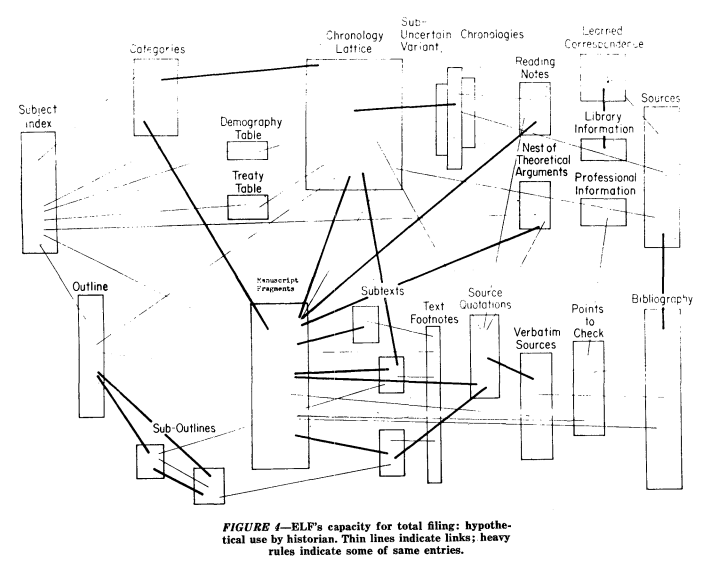Hypertext, although a still-burgeoning form of media, I feel is not being used to its fullest potential. Of course, there are millions of websites and fancy PDFs, but there is still something missing. Hypertext has the potential to make essays, fictions, and other media like videos or photosets more interesting
The idea of using hypertext or hypermedia is by no means new. "Memex" was a term by Vannevar Bush to describe a hypothetical system linking all media one owns, allowing for rapid access. Bush came up with the idea in an attempt to replicate the human mind’s ability to rapidly jump to adjacent ideas [1]. Later, Ted H. Nelson defined “hypertext” and various systems to utilize hypertext in his 1965 publication A File Structure for The Complex, The Changing and the Indeterminate. Hypertext was originally defined as a sort of inter-linked text that would be unable to be “conveniently [...] represented on paper” [2].
Nowadays, you probably recognize hypertext for its use on the internet, linking between pages. Early innovators in the ’90s created hypermedia experiences, using the nature of links and the traversal of the internet to create a new form of media. For example, Olia Lialina’s My Boyfriend Came Back from the War (1996), Mark Amerika’s GRAMMATRON (1997), and Radiohead’s The Bends era website all used forking paths to create a novel (for the time) experience. Other creators like John McDaid used non-internet mediums such as Hypercard to create similar experiences. More modern examples include Fauux, are you lost?, and some ARGs.
Despite all of these great examples, I still feel as if something is missing. We’re not using this medium to its full potential. So far, it seems that hypertext/hypermedia has been only used to tell fictional or abstract stories. If we look back at Nelson’s original paper, he provides this diagram on the last page:

Although this diagram shows an example of the ELF file system being used to keep track of documents for study, I believe that this wiki-esc system could be used to create a more comprehensive and intuitive informative nonfiction. When Bush came up with his Memex, he envisioned a system that would work like one’s memories. We could take inspiration from the ELF to create smaller pages branching out from the main writing to allow for tangents to be included by the author for a more full experience.
One style of hypermedia I would like to see more of is that that is seen in the Serial Experiments Lain PS1 game. I must admit, I haven’t played it much, but from what I have seen, it proves interesting. Any “text”, be it fiction or not, could be interesting in this format. I also think that we shouldn’t limit these things to “texts”. Of course, multimedia is not just on the table, it encompasses it, maybe even like a tablecloth. What I think should be toyed with is the use of images and videos as a base. Take a look at superbad.com. Although it is not a narrative, it creates an experience that moves the traverser as if it was a story. Perhaps a narrative could be told like superbad.com doesn’t.
Someimes I worry that hypermedia will end up being forgotten as just a gimmick. Take a look back at some of the previous sites, such as the old radiohead website and superbad. Although they are fun to poke around it, it seems like they aren’t really trying to do anything more than be hypermedia. In their defense, “net art” was fresh and new, and like with early cinema, these artists were just trying to explore the possibilities of this newborn medium. Although net art is still relatively new, I hope that us second or third generation artists can bring something new to the table, and make creations more than just “hypermedia”. House of Leaves by Mark Z. Danielewski is a book that is very hypertext-esque and has gotten lots of popularity because of its nature. One criticism I have seen towards this book is that its actual story is not that great, but it is hailed as great due to its ergodicity. I believe that this same criticism can be levied towards some of these earlier hypertext works.
I also think that hypermedia shouldn’t be entirely self-contained. That is only another limitation we force upon ourselves. In a postmodern world, interconnectedness is something vital to all media, with references and allusions and such being everywhere, for better or for worse. The internet is vast, and something I’ve had to come to terms with is realizing that it’s okay that nothing is entirely original, and that it should be cherished, not resented.
Hypertext should also not be more than just linked text. The word contains “hyper”, a greek-originating word that means something like “above” or “beyond”. With this, I choose to interpret “hypertext” and “hypermedia” to mean something that is more than just text or just media, along with its original intention of meaning something not easily represented in the physical world. I think that artists could make incredible things by practicing this form of work.
Hypermedia is still a burgeoning medium, whose bounds are still being discovered. Despite its (in my eyes) somewhat-rough beginnings, I believe that hypermedia has the potential to be the new video. There are endless possibilities to be had with hypermedia, and I encourage any of you reading this to go ahead and experiment, and push this medium further.
As We May Think by Vannevar Bush, accessed March 21, 2024
A File Structure for The Complex, The Changing and the Indeterminate by T. H. Nelson, accessed March 21, 2024